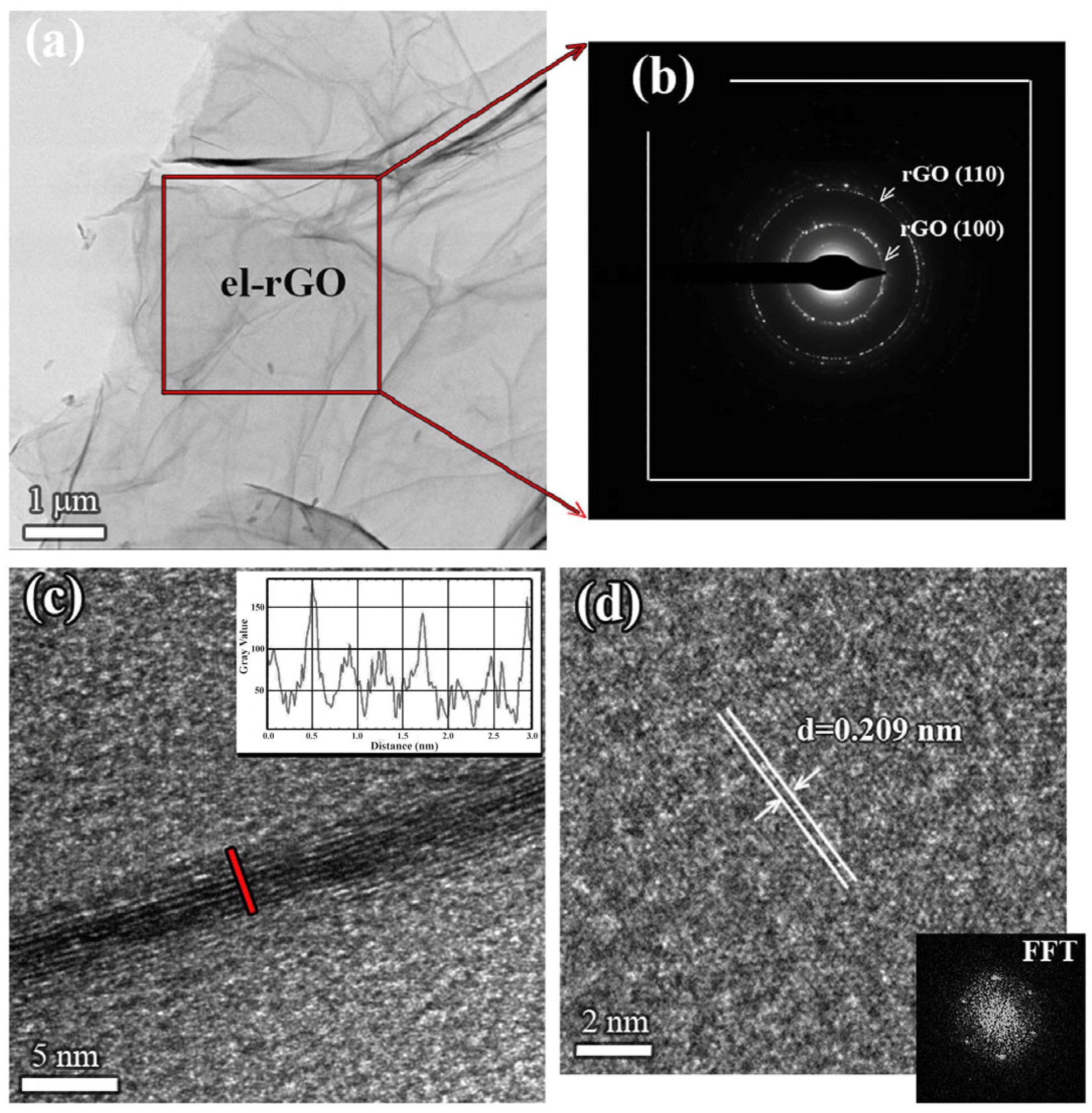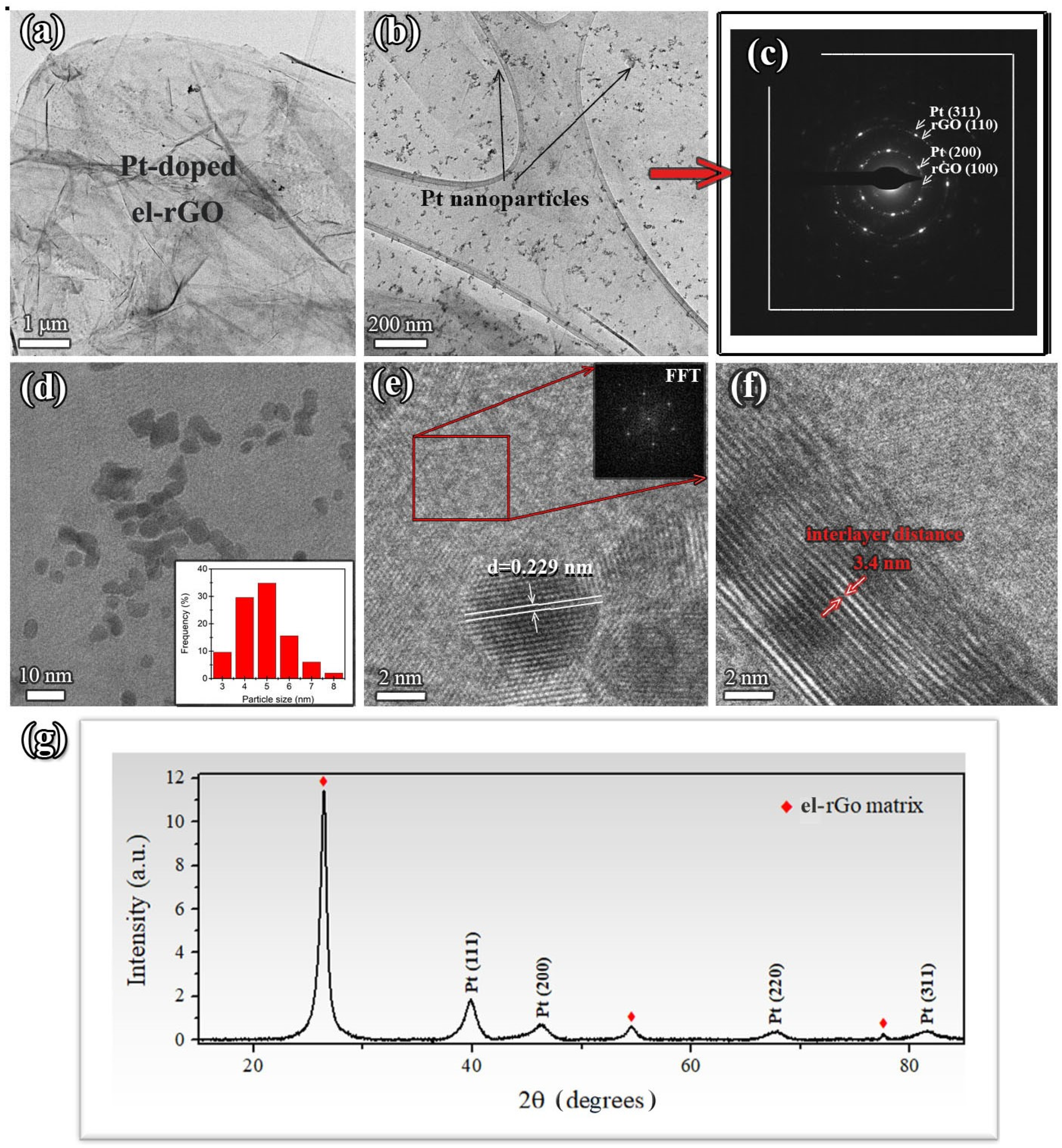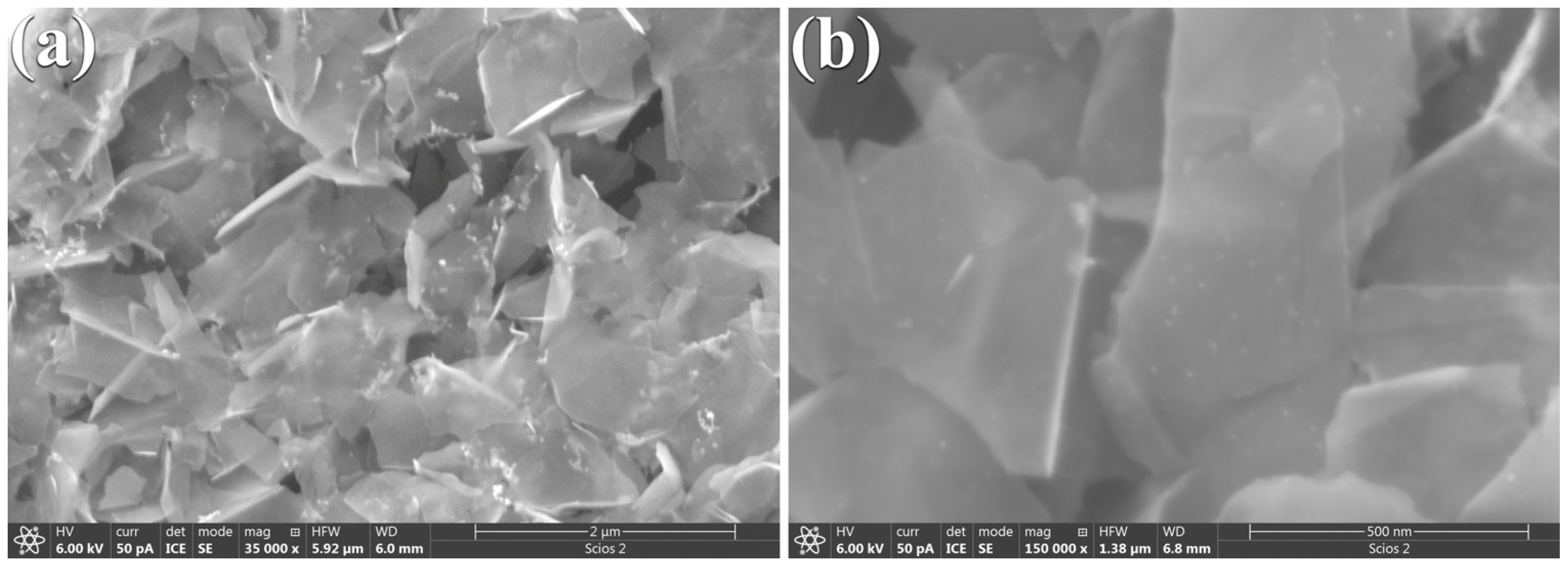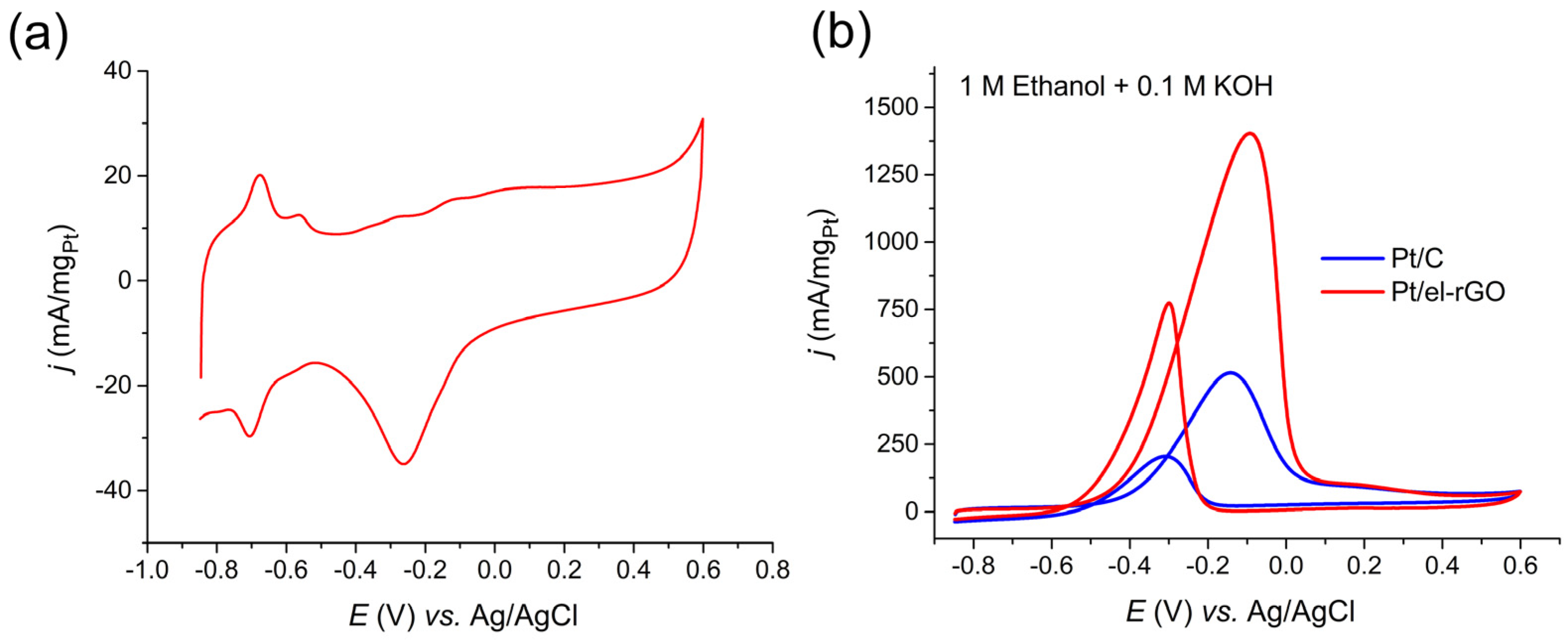Low-Loaded Pt Nanoparticles Supported on Electrochemically Exfoliated Graphene as a Sustainable Catalyst for Electrochemical Ethanol Oxidation
Abstract
:1. Introduction
2. Materials and Methods
2.1. Chemicals
2.2. Materials Preparation
2.2.1. Synthesis of Graphene Sheets
2.2.2. Synthesis of Pt/el-rGO
2.3. Materials Characterization
2.4. Electrochemical Measurements
3. Results and Discussion
3.1. TEM Characterization of Pristine el-rGO and Pt/el-rGO Powder
3.2. SEM Characterization of Pt/el-rGO Electrode
3.3. XPS Characterization of Pt/el-rGO Electrode
3.4. Ethanol Oxidation Reaction at Pt/el-rGO Electrode
4. Conclusions
Author Contributions
Funding
Institutional Review Board Statement
Informed Consent Statement
Data Availability Statement
Conflicts of Interest
References
- Berdysheva, S.; Ikonnikova, S. The Energy Transition and Shifts in Fossil Fuel Use: The Study of International Energy Trade and Energy Security Dynamics. Energies 2021, 14, 5396. [Google Scholar] [CrossRef]
- Jacobs, M. Global Fossil Fuel Economy: Historical Trajectories and Future Challenges. In Affordable and Clean Energy; Leal Filho, W., Marisa Azul, A., Brandli, L., Lange Salvia, A., Wall, T., Eds.; Springer International Publishing: Cham, Swizterland, 2021; pp. 709–719. ISBN 978-3-319-95864-4. [Google Scholar]
- Carrette, L.; Friedrich, K.A.; Stimming, U. Fuel Cells—Fundamentals and Applications. Fuel Cells 2001, 1, 5–39. [Google Scholar] [CrossRef]
- Ong, B.C.; Kamarudin, S.K.; Basri, S. Direct Liquid Fuel Cells: A Review. Int. J. Hydrogen Energy 2017, 42, 10142–10157. [Google Scholar] [CrossRef]
- Antolini, E.; Gonzalez, E.R. Alkaline Direct Alcohol Fuel Cells. J. Power Sources 2010, 195, 3431–3450. [Google Scholar] [CrossRef]
- Antolini, E. Pt-Ni and Pt-M-Ni (M = Ru, Sn) Anode Catalysts for Low-Temperature Acidic Direct Alcohol Fuel Cells: A Review. Energies 2017, 10, 42. [Google Scholar] [CrossRef]
- Yaqoob, L.; Noor, T.; Iqbal, N. A Comprehensive and Critical Review of the Recent Progress in Electrocatalysts for the Ethanol Oxidation Reaction. RSC Adv. 2021, 11, 16768–16804. [Google Scholar] [CrossRef]
- Roschger, M.; Wolf, S.; Genorio, B.; Hacker, V. Effect of PdNiBi Metal Content: Cost Reduction in Alkaline Direct Ethanol Fuel Cells. Sustainability 2022, 14, 15485. [Google Scholar] [CrossRef]
- Eigler, S.; Hirsch, A. Chemistry with Graphene and Graphene Oxide—Challenges for Synthetic Chemists. Angew. Chem. Int. Ed. 2014, 53, 7720–7738. [Google Scholar] [CrossRef]
- Bai, J.; Liu, D.; Yang, J.; Chen, Y. Nanocatalysts for Electrocatalytic Oxidation of Ethanol. ChemSusChem 2019, 12, 2117–2132. [Google Scholar] [CrossRef]
- Rizo, R.; Pérez-Rodríguez, S.; García, G. Well-Defined Platinum Surfaces for the Ethanol Oxidation Reaction. ChemElectroChem 2019, 6, 4725–4738. [Google Scholar] [CrossRef]
- Smiljanić, M.; Srejić, I.; Georgijević, J.P.; Maksić, A.; Bele, M.; Hodnik, N. Recent Progress in the Development of Advanced Support Materials for Electrocatalysis. Front. Chem. 2023, 11, 1304063. [Google Scholar] [CrossRef] [PubMed]
- Ren, F.; Wang, H.; Zhai, C.; Zhu, M.; Yue, R.; Du, Y.; Yang, P.; Xu, J.; Lu, W. Clean Method for the Synthesis of Reduced Graphene Oxide-Supported PtPd Alloys with High Electrocatalytic Activity for Ethanol Oxidation in Alkaline Medium. ACS Appl. Mater. Interfaces 2014, 6, 3607–3614. [Google Scholar] [CrossRef] [PubMed]
- Li, L.; Chen, M.; Huang, G.; Yang, N.; Zhang, L.; Wang, H.; Liu, Y.; Wang, W.; Gao, J. A Green Method to Prepare Pd–Ag Nanoparticles Supported on Reduced Graphene Oxide and Their Electrochemical Catalysis of Methanol and Ethanol Oxidation. J. Power Sources 2014, 263, 13–21. [Google Scholar] [CrossRef]
- Antolini, E. Graphene as a New Carbon Support for Low-Temperature Fuel Cell Catalysts. Appl. Catal. B Environ. 2012, 123–124, 52–68. [Google Scholar] [CrossRef]
- Dong, L.; Gari, R.R.S.; Li, Z.; Craig, M.M.; Hou, S. Graphene-Supported Platinum and Platinum–Ruthenium Nanoparticles with High Electrocatalytic Activity for Methanol and Ethanol Oxidation. Carbon 2010, 48, 781–787. [Google Scholar] [CrossRef]
- Shen, Y.; Xiao, K.; Xi, J.; Qiu, X. Comparison Study of Few-Layered Graphene Supported Platinum and Platinum Alloys for Methanol and Ethanol Electro-Oxidation. J. Power Sources 2015, 278, 235–244. [Google Scholar] [CrossRef]
- Vu, T.H.T.; Nguyen, T.T.; Nguyen, T.H.; Nguyen, M.D.; Nguyen, Q.M. A New Method for Synthesizing High Performance Few-Layer Graphene Supported Pt Electrocatalysts in Methanol and Ethanol Oxidation. Electrochim. Acta 2021, 380, 138258. [Google Scholar] [CrossRef]
- Arukula, R.; Vinothkannan, M.; Kim, A.R.; Yoo, D.J. Cumulative Effect of Bimetallic Alloy, Conductive Polymer and Graphene toward Electrooxidation of Methanol: An Efficient Anode Catalyst for Direct Methanol Fuel Cells. J. Alloys Compd. 2019, 771, 477–488. [Google Scholar] [CrossRef]
- Ruiz-Camacho, B.; Medina-Ramírez, A.; Villicaña Aguilera, M.; Minchaca-Mojica, J.I. Pt Supported on Mesoporous Material for Methanol and Ethanol Oxidation in Alkaline Medium. Int. J. Hydrogen Energy 2019, 44, 12365–12373. [Google Scholar] [CrossRef]
- Sun, S.; Zhang, G.; Gauquelin, N.; Chen, N.; Zhou, J.; Yang, S.; Chen, W.; Meng, X.; Geng, D.; Banis, M.N.; et al. Single-Atom Catalysis Using Pt/Graphene Achieved through Atomic Layer Deposition. Sci. Rep. 2013, 3, 1775. [Google Scholar] [CrossRef]
- Berghian-Grosan, C.; Radu, T.; Biris, A.R.; Dan, M.; Voica, C.; Watanabe, F.; Biris, A.S.; Vulcu, A. Platinum Nanoparticles Coated by Graphene Layers: A Low-Metal Loading Catalyst for Methanol Oxidation in Alkaline Media. J. Energy Chem. 2020, 40, 81–88. [Google Scholar] [CrossRef]
- Su, C.-Y.; Lu, A.-Y.; Xu, Y.; Chen, F.-R.; Khlobystov, A.N.; Li, L.-J. High-Quality Thin Graphene Films from Fast Electrochemical Exfoliation. ACS Nano 2011, 5, 2332–2339. [Google Scholar] [CrossRef] [PubMed]
- Abdelkader, A.M.; Cooper, A.J.; Dryfe, R.a.W.; Kinloch, I.A. How to Get between the Sheets: A Review of Recent Works on the Electrochemical Exfoliation of Graphene Materials from Bulk Graphite. Nanoscale 2015, 7, 6944–6956. [Google Scholar] [CrossRef] [PubMed]
- Munuera, J.M.; Paredes, J.I.; Villar-Rodil, S.; Ayán-Varela, M.; Pagán, A.; Aznar-Cervantes, S.D.; Cenis, J.L.; Martínez-Alonso, A.; Tascón, J.M.D. High Quality, Low Oxygen Content and Biocompatible Graphene Nanosheets Obtained by Anodic Exfoliation of Different Graphite Types. Carbon 2015, 94, 729–739. [Google Scholar] [CrossRef]
- Shalaby, A.; Nihtianova, D.; Markov, P.; Staneva, A.D.; Iordanova, R.S.; Dimitriev, Y.B. Structural Analysis of Reduced Graphene Oxide by Transmission Electron Microscopy. Bulg. Chem. Commun. 2015, 47, 291–295. [Google Scholar]
- Hayes, W.I.; Joseph, P.; Mughal, M.Z.; Papakonstantinou, P. Production of Reduced Graphene Oxide via Hydrothermal Reduction in an Aqueous Sulphuric Acid Suspension and Its Electrochemical Behaviour. J. Solid State Electrochem. 2015, 19, 361–380. [Google Scholar] [CrossRef]
- Li, X.; Fan, L.; Li, Z.; Wang, K.; Zhong, M.; Wei, J.; Wu, D.; Zhu, H. Boron Doping of Graphene for Graphene–Silicon p–n Junction Solar Cells. Adv. Energy Mater. 2012, 2, 425–429. [Google Scholar] [CrossRef]
- Dresselhaus, M.S.; Dresselhaus, G.; Eklund, P.C. Science of Fullerenes and Carbon Nanotubes; Academic Press: Cambridge, MA, USA, 1996; ISBN 978-0-12-221820-0. [Google Scholar]
- Duan, X.; O’Donnell, K.; Sun, H.; Wang, Y.; Wang, S. Sulfur and Nitrogen Co-Doped Graphene for Metal-Free Catalytic Oxidation Reactions. Small 2015, 11, 3036–3044. [Google Scholar] [CrossRef]
- Rakočević, L.; Simatović, I.S.; Maksić, A.; Rajić, V.; Štrbac, S.; Srejić, I. PtAu Nanoparticles Supported by Reduced Graphene Oxide as a Highly Active Catalyst for Hydrogen Evolution. Catalysts 2022, 12, 43. [Google Scholar] [CrossRef]
- Golubović, J.; Rakočević, L.; Vasiljević Radović, D.; Štrbac, S. Improved Oxygen Reduction on GC-Supported Large-Sized Pt Nanoparticles by the Addition of Pd. Catalysts 2022, 12, 968. [Google Scholar] [CrossRef]
- Maksic, A.; Rakocevic, Z.; Smiljanic, M.; Nenadovic, M.; Strbac, S. Methanol Oxidation on Pd/Pt(Poly) in Alkaline Solution. J. Power Sources 2015, 273, 724–734. [Google Scholar] [CrossRef]
- Schmidt, T.J.; Ross, P.N., Jr.; Markovic, N.M. Temperature Dependent Surface Electrochemistry on Pt Single Crystals in Alkaline Electrolytes Part 2. The Hydrogen Evolution/Oxidation Reaction. J. Electroanal. Chem. 2002, 524–525, 252–260. [Google Scholar] [CrossRef]
- Chen, Z.; Liu, T.; Zhang, H.; Pang, B.; Sun, Y.; Hu, L.; Luo, Q.; Liu, X.; Cao, L.; Yao, T. Laser-Assisted Synthesis of PtPd Alloy for Efficient Ethanol Oxidation. Nano Res. 2024, 17, 6032–6037. [Google Scholar] [CrossRef]
- Tang, M.; Sun, M.; Chen, W.; Ding, Y.; Fan, X.; Wu, X.; Fu, X.-Z.; Huang, B.; Luo, S.; Luo, J.-L. Atomic Diffusion Engineered PtSnCu Nanoframes with High-Index Facets Boost Ethanol Oxidation. Adv. Mater. 2024, 36, 2311731. [Google Scholar] [CrossRef]
- Bastos, T.L.; Gelamo, R.V.; Colmati, F. Carbon-Graphene Hybrid Supporting Platinum–Tin Electrocatalyst to Enhance Ethanol Oxidation Reaction. J. Appl. Electrochem. 2024, 54, 1225–1237. [Google Scholar] [CrossRef]
- Liu, C.; Tang, Q.; Fan, P.; Wei, Y.; Yu, Y.; Wen, X.; Li, X.; Li, L.; Qu, Q. Interface Engineering of PdPt Ultrafine Ethanol Electro-Oxidation Nanocatalysts by Bacterial Soluble Extracellular Polymeric Substances (s-EPS) to Break through Sabatier Principle. Small 2024, 20, 2308283. [Google Scholar] [CrossRef] [PubMed]
- Zhang, Z.; Fu, H.; Chen, C.; Huang, Z.; Guan, L.; Li, H.; Zhang, N.; Liu, T. Defect-Rich Pt-Ru Metallic Aerogels for Highly Efficient Ethanol Oxidation Reaction. Appl. Surf. Sci. 2024, 652, 159277. [Google Scholar] [CrossRef]
- Eswaraditya Reddy, L.; Gollapudi, D.; Mahnot Jain, G.; Kolluru, S.; Ramesh, G.V. Recent Progress in the Development of Platinum-Based Electrocatalysts for the Oxidation of Ethanol in Fuel Cells. Mater. Today Proc. 2023, 92, 636–641. [Google Scholar] [CrossRef]







Disclaimer/Publisher’s Note: The statements, opinions and data contained in all publications are solely those of the individual author(s) and contributor(s) and not of MDPI and/or the editor(s). MDPI and/or the editor(s) disclaim responsibility for any injury to people or property resulting from any ideas, methods, instructions or products referred to in the content. |
© 2024 by the authors. Licensee MDPI, Basel, Switzerland. This article is an open access article distributed under the terms and conditions of the Creative Commons Attribution (CC BY) license (https://creativecommons.org/licenses/by/4.0/).
Share and Cite
Srejić, I.; Maksić, A.; Novaković, M.; Potočnik, J.; Rakočević, L.; Živković, S.; Smiljanić, M. Low-Loaded Pt Nanoparticles Supported on Electrochemically Exfoliated Graphene as a Sustainable Catalyst for Electrochemical Ethanol Oxidation. Sustainability 2024, 16, 8189. https://doi.org/10.3390/su16188189
Srejić I, Maksić A, Novaković M, Potočnik J, Rakočević L, Živković S, Smiljanić M. Low-Loaded Pt Nanoparticles Supported on Electrochemically Exfoliated Graphene as a Sustainable Catalyst for Electrochemical Ethanol Oxidation. Sustainability. 2024; 16(18):8189. https://doi.org/10.3390/su16188189
Chicago/Turabian StyleSrejić, Irina, Aleksandar Maksić, Mirjana Novaković, Jelena Potočnik, Lazar Rakočević, Sanja Živković, and Milutin Smiljanić. 2024. "Low-Loaded Pt Nanoparticles Supported on Electrochemically Exfoliated Graphene as a Sustainable Catalyst for Electrochemical Ethanol Oxidation" Sustainability 16, no. 18: 8189. https://doi.org/10.3390/su16188189
APA StyleSrejić, I., Maksić, A., Novaković, M., Potočnik, J., Rakočević, L., Živković, S., & Smiljanić, M. (2024). Low-Loaded Pt Nanoparticles Supported on Electrochemically Exfoliated Graphene as a Sustainable Catalyst for Electrochemical Ethanol Oxidation. Sustainability, 16(18), 8189. https://doi.org/10.3390/su16188189






